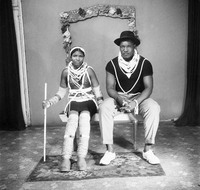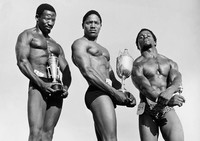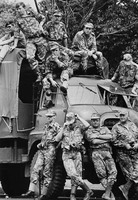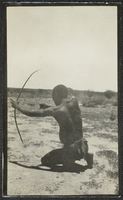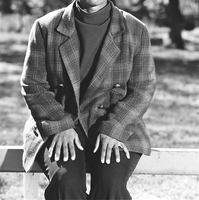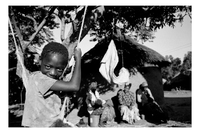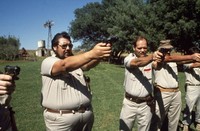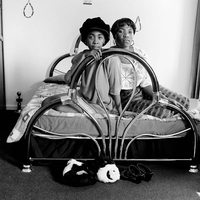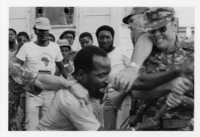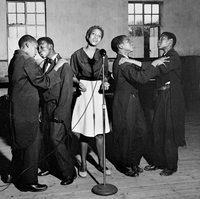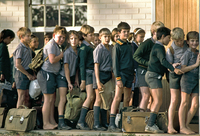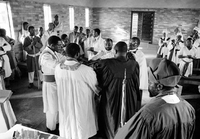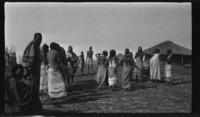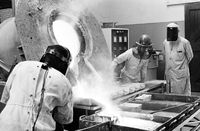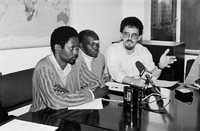Browse through a selection of the UCT Photography Collection.
-
Anne Fischer Photographic Collection
Anne Fischer (1914-1986) was born in Berlin and orphaned at sixteen. After training as a photographer’s apprentice in a portrait studio in Germany, she fled that country shortly before World War II and arrived in Cape Town in 1937 as a penniless Jewish refugee. There she established a reputation as a fine portrait photographer and ran a flourishing commercial business. By the 1960s she was regarded as Cape Town’s pre-eminent wedding and theater photographer. Several other prominent women photographers of the time, including Jansje Wissema, trained in her studio. Fischer was not only a successful commercial photographer: she also produced a substantial body of documentary work. In the late 1930s she joined Cape Town’s political left and produced images in Langa, the rural areas of the former Transkei and Basutoland, and the ‘coloured’ missionary town of Genadendal . While a small selection of her digitized negatives can be seen below, additional examples of her work can be found across several other archives in the University of Cape Town Libraries Special Collections. -
Arthur Bolton Photographic Collection
Arthur Bolton was a radiologist who settled in KwaZulu Natal after the Second World War. He was keen photographer whose work is predominently about Zulu culture in the field as well in a studio. He also worked with the Killie Campbell Museum in Durban. This body of work which has been looked after by his daughter Gail Catlin has recently come to light.It reflects his close interest in Zulu people from the period 1940-1960 as well his documentation on his family. These two worlds, the outside and the inside represent a very interesting dialogue running through this collection. -
Basil Breakey Photographic Collection
Basil Breakey is best known for his photographs of the twilight years of the dynamic jazz subculture that flourished in South Africa, and particularly in Johannesburg, until the early 1960s, when it was finally crushed by the apartheid state. -
Daniel Morolong Photographic Collection
Daniel Morolong’s photographs tell the ‘other’ story of life in the black urban residential areas of the city, at a time when apartheid’s political agendas were beginning to unfold. The authorities and the residents of East London’s locations have always seen and understood the locations differently. To the authorities, they were overcrowded and filthy, a breeding ground for poverty, disease and crime. These conditions were seen to reflect the characters of people – somehow less than human. Racist images of people and the locations dominated public life. These photographs on show how residents saw the locations. They portray life in the locations as rich, dynamic and vibrant. In an extraordinary way they show the very ordinary nature of social life and living and therefore picture aspects of life that apartheid denied and 'whiteness' kept hidden. Despite a long list of artificial restrictions imposed by apartheid on their lives, location residents made their own definitions of what it really meant to be 'the other’ in white South Africa. As such, when they remember their lives in these old locations, it is neither the poverty nor the hardship that they remember most. Rather, it is the social diversity, cultural vibrancy and sense of identity that first come to mind. -
Dorothea Bleek Photographic Collection
Dorothea Bleek was the fifth daughter of Dr Wilhelm Bleek, the noted philologist, who, with his sister-in-law, Lucy Lloyd, did an enormous and pioneering job of recording the language and folklore of the /Xam and the ǃKung in the late 19th century. Dorothea Bleek continued the work of her father and aunt, recording and documenting the San languages of Southern Africa and publishing books and articles based both on her own work and theirs. Her most important work, published after her death, was A Bushman Dictionary. She undertook many expeditions in the course of her research on the different San groups, their languages and rock art. In 1910 she visited the area near Prieska in the northern Cape, from where some of the San informants interviewed by her father and aunt had originated. Subsequent travels included trips to other parts of the northern Cape, the eastern Transvaal, South West Africa (present Namibia), Bechuanaland (Botswana), Angola and Tanganyika. -
Giséle Wulfsohn Photographic Collection
Gisèle Wulfsohn is a freelance photographer based in Johannesburg. In the early 1980s, she worked for the Star newspaper and Style magazine. By the mid-80s, she had joined Afrapix, a photographic collective that documented the anti-apartheid struggle. In 1994, she was among the photographers commissioned by the Independent Electoral Commission (IEC) to document the first democratic elections in South Africa. In post-apartheid South Africa, Wulfsohn has worked on assignment for numerous local and international publications and non-government organizations. She is primarily concerned with gender issues, education, and health. She has been documenting the manifestations of HIV/AIDS in South Africa since the late 1980s. -
Greame Williams Photographic Collection
Graeme Williams was born in Cape Town in 1961. He studied geology and statistics but chose to work as a freelance photographer. Williams settled in Johannesburg in 1988 where he worked for Reuters covering the resistance to apartheid and the movement toward African National Congress rule. Since South Africa’s transition to democracy, he has increasingly concentrated on documentary projects and magazine work. Williams’ photography has been exhibited in South Africa, Europe, Australia, and the United States, and is held in a number of permanent collections. His latest color work focuses on the details of people’s lives as a means of exploring change and the lack of change in contemporary South African society. -
Greg Marinovich Photographic Collection
Greg Marinovich, born in South Africa in 1962, is a Pulitzer Prize-winning photographer and is co-author of The Bang Bang Club, a non-fiction book and film on South Africa’s transition to democracy.He has spent 18 years doing conflict, documentary and news photography around the globe. His photographs have appeared in top international publications such as Time, Newsweek, The New York Times, The Washington Post, Wall Street Journal, The Guardian of London, among others. He is chair of the World Press master Class nominating committee for Africa, and was a World Press Photo judge in 1994, as well as convenor of the FujiFilm awards in 2000.For the last decade he has been photographing, making films and writing as a freelancer. He has done a lot of teaching and mentoring and is presently involved in a storytelling multi-media across Africa. He is the initiator of the Open Society photography project. -
Guy Tillim Photographic Collection
Guy Tillim was born in Johannesburg in 1962. He completed a degree in commerce at the University of Cape Town, but turned to full-time photography instead. In 1986 he joined Afrapix, a collective of South African photographers that supplied news and feature images -- notably about the struggle against apartheid -- to the local and international media. In that period he worked for Reuters in South Africa, and he also worked for Agence France Presse in the run-up to the first democratic elections in South Africa in 1994. From 1990 onwards Tillim broadened the scope of his work to Africa and elsewhere. He worked on assignment for various international publications, but also pursued his own projects, resulting in a number of major documentary essays From 1998 onwards he has increasingly concentrated on his own work. He now lives in Cape Town. Tillim’s work has been exhibited throughout the world, and is held in various permanent collections. -
Jansje Wissema Photographic Collection
Jansje Wissema, A Dutch photographer, was commissioned by the then Cape Institute of Architects (now the Cape Institute for Architecture) to record District Six in the 1970s when it became clear that the government was intent on destroying the area. Her iconic images of the place and its people have remained as a powerful chronicle of the area, capturing the essence of this once-vital community. The Cape Institute for Architecture, in conjunction with the District Six Museum, collaborated with the South African Centre for Photography to present an exhibition during the Cape Town Month of Photography ( MOP5) in 2012. A selection of 40 of these digital photographic prints were exhibited to the public for the first time. Source: https://www.districtsix.co.za/project/district-six-people-lived-here/ -
Jürgen Schadeberg Photographic Collection
Jürgen Schadeberg was a German-born South African photographer and artist. He photographed key moments in South African history, including iconic photographs such as Nelson Mandela at Robben Island prison. He also lived, worked and taught in London and Spain, and photographed in many African countries. -
Martin West Photographic Collection
Emeritus Professor Martin West's evocative collection of photographs, taken of the Africa Independent Churches in Soweto between 1969 and 1971, show a segment of society hidden to most South Africans. Starting at the end of the nineteenth century, African independent churches flourished in South Africa in the rural areas and in the cities. West’s research remains one of the few intensive studies of these churches. It culminated in his book, Martin West: Bishops and Prophets in a Black City, published in the 1970s. The young social scientist took hundreds of images, capturing baptisms, sacrificial slaughters, prayer meetings, healing services, and vignettes of everyday life in Soweto. -
Paul Grendon Photographic Collection
Paul Grendon is a Cape Town based photographer and a graduate of the Michaelis School of Fine Art at UCT. He joined the Afrapix collective in the 1980’s and has worked as a documentary photographer and photographic curator since then. His defining career work was on the communities who struggled to regain control of their land in Namaqualand during Apartheid and he is presently working on a long term project on the church bands of the Cape Flats.
-
Beyond Barricades Exhibition
Beyond the Barricades (Editors, Omar Badsha, Gideon Mendel and Paul Weinberg). This important collection (book and exhibition) of photographs by twenty South African photographers, mainly from the photographic collective, Afrapix, represents as written in the book, “an eloquent and searing testimony of the communal struggle as witnessed and expressed by South Africans.” It has become an indispensable anthology of popular resistance in South Africa during the 1980’s. The collection highlights one of the longest and bloodiest periods of political resistance to apartheid, a time of mass mobilization and brutal repression when taking of images was often a matter of life and death. This digital collection is from the book, the full collection is housed in Special Collections, UCT Libraries. -
The Cordoned Heart Exhibition
Cordoned Heart (Editor and Curator, Omar Badsha). This collection of images were taken by 28 photographers for the Second Carnegie Inquiry into Poverty and Development in 1983. The exhibition toured South Africa and different parts of the world. In many ways it was something like The Farm Security Administration Project that took place in USA in the 1930s. The photographic essays explored, as the book suggested, ‘beyond the cordon thrown by the apartheid state into the heart of this complex and deeply troubled society.’ It was, at the time, the largest documentary project that examined poverty and development in South Africa and has become a milestone in the visual history of our country. The full physical collection is housed in Special Collections, UCT Libraries and this selection here is what appeared in the book.



